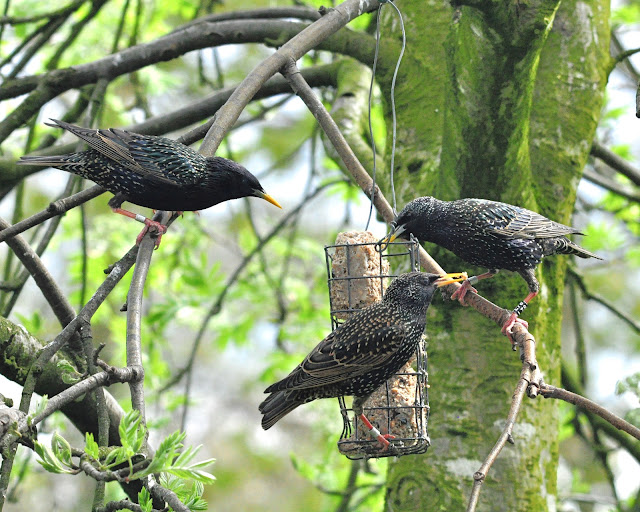Much of my ringing effort over the last 3 weeks has been directed towards my Starling RAS project and I have clocked up around 75 hours of recording colour-ringed Starlings feeding on the fat blocks in the garden. As I have been running the project for a few years most of my local Starlings are colour-ringed and I have resighted 100 Starlings that were ringed prior to the start of this year's recording period with over 25% of those birds being more than 3 years old. It didn't take long to record the first 60 or so individuals but after that it became more like looking for a needle in a haystack as it gets progressively harder to pick out any that haven't been recorded before from all the ones that visit the fat blocks on numerous occasions each day. In addition to recording all the previously ringed birds I selectively trap and ring any unringed Starlings to add them to the study population with 20 new adults being ringed and colour-ringed so far.
 |
| With at least 70+ different Starlings coming they are currently getting through 1.5 to 2 kg of home made fat blocks each day. This will increase as more young fledge. |
 |
| It is often a bit of a scrum at the fat blocks with the birds jostling for position. This can make reading the codes on the colour-rings quite difficult. |
 |
| Adult male A12 is one of the many regulars and was originally ringed in December 2014. This male has been recorded numerous times in each breeding season since being ringed. |
 |
| The first juvenile ringed in 2018. This bird was caught earlier this morning (14/05/2018). The first juvenile was ringed on the same date last year and on 7th May in 2016. |

Hi Pete
ReplyDeleteI had one of which I assume is your colour ringed Starlings in my garden this morning. Black ring with white J86 I think. It was collecting food so must be nesting locally. Its not traveled very far as I'm in Derby Drive, Rainford.
Any info appreciated
Regards
Damian
Hi Damian,
DeleteThat will be one I ringed in the garden in 2016. Please email me at starling.ringer@gmail.com and I will send you the details. Many Thanks. Peter